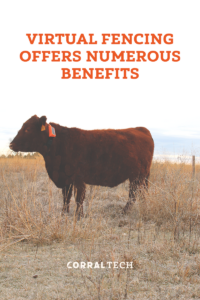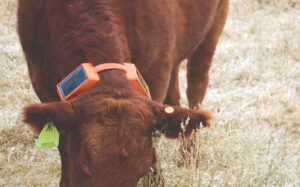What if your ranching operation could have lower input costs for fencing and require less labor for fencing, while making gains in carrying capacity, manure distribution, soil health and animal health? It would be a no-brainer, right? Virtual fencing takes the concept of invisible fencing for pets and applies it to livestock.

Two of the benefits of virtual fencing are that virtual fencing doesn’t require the high input costs associated with building fence, and less labor is needed to manage virtual fencing, while building new fences and maintaining existing fences are labor-intensive on the ranch. In addition, managing rotational grazing for cattle can also require regularly moving animals and fencing—another job that takes valuable time and manpower on the ranch.
“More than 80% of cow-calf producers out there today have another job that’s their primary income source,” says Jack Keating, founder and CEO of Corral Technologies. “Ultimately, going out and moving fences daily—or even once a week—could be a major pain for them.”
Virtual fencelines can be drawn with the touch of a button, dividing up larger pastures into paddocks, which increases the carrying capacity of the pasture. In addition, manure is distributed more evenly across the land, boosting soil health.
In time, cattle producers who utilize virtual fencing will see improved forage quality and production, as well as improved herd health.
 “With this system, ranchers are able to improve operation management, but at the same time, also help the environment,” Keating says. “The Corral Tech system can be used on the web, your computer, or on your phone.”
“With this system, ranchers are able to improve operation management, but at the same time, also help the environment,” Keating says. “The Corral Tech system can be used on the web, your computer, or on your phone.”
As long as your device is connected to the Internet and cattle are within cellular service, cattle can be moved from anywhere. There are also no limitations to where fences can be created in the software program.
The program can generate a heat map showing where cattle have grazed, so cattle producers can better utilize all of their grazing acres.
Alerts are sent to the manager when cattle go beyond the virtual fencelines or if a cow is not moving after three hours. Keating says that more functionality will be coming.
“Recordkeeping is another nice feature that we have implemented into the system that allows us to keep track of things,” Keating says. “If you have multiple people working on your operation, you’re able to notify the others on your team that a cow is sick.”
The unique design of the adjustable Corral Technologies collars ensures that cattle producers are able to get a great fit on cows. The rubber device can stay on a cow for up to two years, according to Keating. The collars are operated by small solar panels, so collars are charged at all times.
“The collars will last about 7-14 days without any sun exposure, but it only takes a day or so of sun to charge,” Keating says.
 When an animal approaches a fenceline, it receives directional stimulation. The cow will receive stimulation on either the right or left side, depending on which way it’s going.
When an animal approaches a fenceline, it receives directional stimulation. The cow will receive stimulation on either the right or left side, depending on which way it’s going.
Interested in learning more? Contact us today.